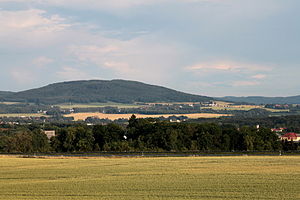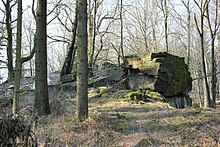Thromberg
| Thromberg / Lubin | ||
|---|---|---|
|
The Thromberg of Salzenforst from |
||
| height | 432 m above sea level NN | |
| location | approx. 6 km southeast of the city center of Bautzen , Saxony ( Germany ) | |
| Mountains | Lusatian highlands | |
| Dominance | 3.5 km → Hromadnik | |
| Coordinates | 51 ° 7 '53 " N , 14 ° 27' 15" E | |
|
|
||
| rock | Granodiorite | |
The Thromberg ( Upper Sorbian Lubin ), also called Drohmberg, Thronberg or Traumberg, is a 432 m high mountain near Bautzen in Saxony. It is also regarded as its local mountain.
location
It is located approx. 6 km southeast of the city center of Bautzen. To the southwest lies the community of Großpostwitz , to the west the district of Rascha, to the northwest the district of Ebendörfel , to the north the district of Binnewitz and to the southeast the district of Cosul .
The mountain is part of the northernmost mountain range of the Oberlausitzer Bergland , which culminates in the Czorneboh . It represents an impressive cornerstone against the westernmost Spreetal represents, from which the southwestern mountain foot by 200 m rises.
Geology, soil science, hydrology and flora and fauna
The rock of the Thromberg, a two-mica granodiorite, appears on the summit in rocky cliffs (known as the Devil's Pulpit) approx. 3 m high. Blocks are scattered on the upper slope.
Loess loam, which originally covered the summit area, was relocated down the slope with the periglacial floating earth. In the area of the lower slope it is more than 0.5 m thick. The upper slope and the plateau have only a thin layer of flowing earth above the heavily fissured bedrock, which forms a gritty and stony weathered soil.
In the case of an unfavorable water balance in the often waterlogged or rapidly drying soils (pseudogleye and acidic podsolous brown earths), especially since there are no bodies of water apart from small sources on the southern slope, the forest has poor growth conditions. The heavy "devastation" of the forest goes back in part to forest pasture and litter use up to 1840. For this reason, the entire southern slope has passed into the possession of the Council of Budissin from Hainitz and Postwitz since 1471 and 1507 (111 ha); from 1819 on it was mostly planted with larch . In 1846, the city of Bautzen placed a memorial stone for the responsible city treasurer, Johann Gottlob Postel, which still stands today on the southern edge of the forest on the Thromberg. Instead of the original oak-birch forest, however, mainly spruce was planted in the following decades.
Numerous blackberry species often grow on the edges and in clearings of the forest. Notable species are the two-colored blackberry (Rubus bifrons) , a characteristic species of the northern mountain range, the Silesian blackberry (R. silesiacus) and the mountain blackberry (R. senticosus) . As far as fauna is concerned, it is worth mentioning that the dormouse was found on Thromberg in 1920 .
history

In contrast to old documents where the name of the mountain Troyenberg (1404) or Tronberg (1471) was written, Oeder named the height in 1597 after the nearby town Ebendörfel - at that time Bellschwitz - as "Beltzwitzer Bergk".
With a wall made of larger stones on the open east side, a flat plateau with a diameter of 10 meters results. Nothing specific is reported about the origin of the wall. However, there is an oral tradition that the Thromberg is said to have served as an observation post for the robber knight's castle " Körse " in the Middle Ages .
legend
According to an old Sorbian legend, seven kings are said to have conferred here on seven stone blocks on the "Lubin" when the Germans invaded the land of the Sorbs. The fight that followed was very bloody. The battle was lost for the Sorbs, and all seven kings lost their lives. They were buried on the mountain together with their crowns and seven blocks were rolled on their graves, which the Germans interpreted as a throne. Similar to the Kyffhauser legend , they should now wait under the mountain for the day when their people will call them to help.
Attractions
Above the outskirts of Ebendörfel on the edge of the forest at about 290 m above sea level, there is a war memorial in honor of those who fell in the First World War. A ring path leads around the mountain. The way to the summit is not signposted.
Individual evidence
- ↑ Andreas Wujanz: The Upper Lusatia as a special division of Saxony's church gallery . Verlag von Hermann Schmidt, Dresden 1840. , digitized, p. 87 ff.
- ^ Drohmberg
literature
- Around Bautzen and Schirgiswalde (= values of the German homeland . Volume 12). 1st edition. Akademie Verlag, Berlin 1967.


